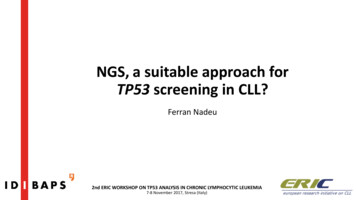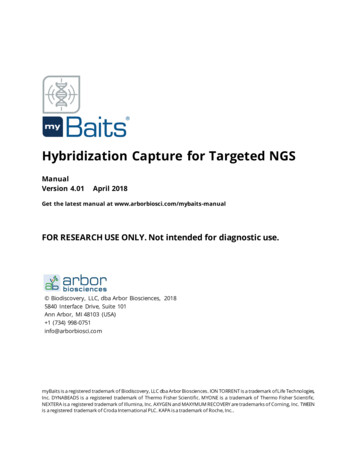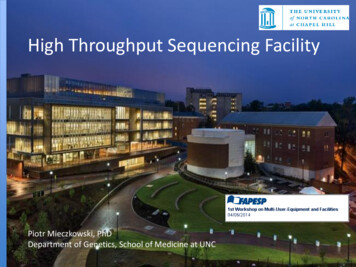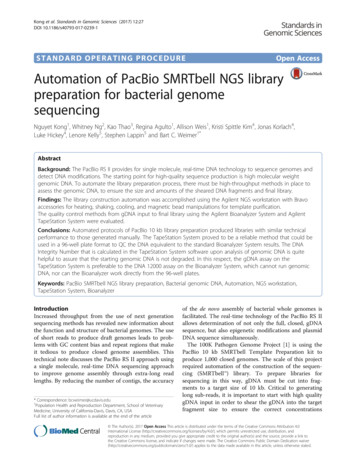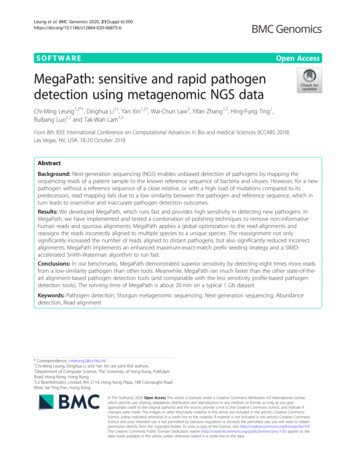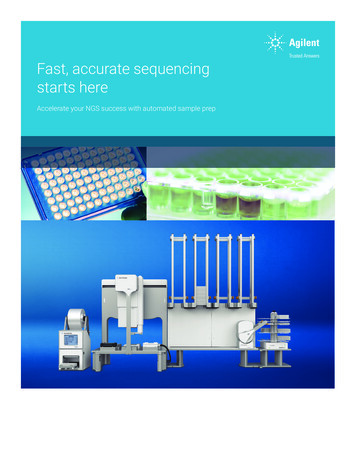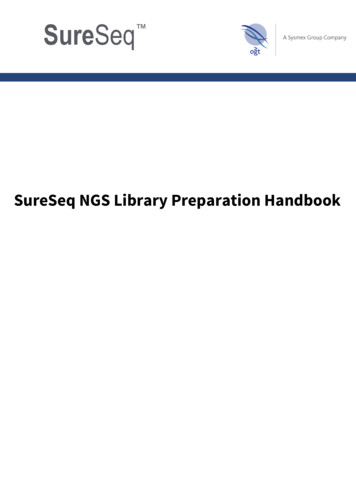
Transcription
SureSeq NGS Library Preparation Handbook
SureSeq NGS Library Preparation HandbookOxford Gene TechnologyFounded by Professor Sir Ed Southern, Oxford Gene Technology (OGT) provides world-classgenetics research solutions. OGT has a strong reputation and increasing share in the large andgrowing genomic medicine market.OGT is part of Sysmex Corporation’s life science business, reinforcing Sysmex’s initiativestowards personalised medicine. CytoSure — Class-leading products and services offering the complete array solution forgenetics research. Cytocell — High-quality fluorescence in situ hybridisation (FISH) probes for the detection ofgene rearrangements related to inherited genetic disease and cancer. SureSeq — Delivering comprehensive, high–quality targeted sequencing products toresearchers.For more information, visit www.ogt.com.SureSeq: For research use only. Not for use in diagnostic procedures.Version 2.0: June 20192
SureSeq NGS Library Preparation HandbookContentsIntroduction . 4Equipment and reagents required . 5Workflow overview. 7Sample requirements . 8Sample Quality Control . 9Pre-hybridisation library preparation. 11Enzymatic DNA fragmentation for good quality gDNA . 12Pre-fragmentation repair treatment for FFPE-derived gDNA. 15Fragmentation of FFPE samples using Fragmentase . 17DNA shearing using Covaris . 20Repair treatment for FFPE-derived gDNA. 22Post-shear purification (Covaris ). 24End repair and 3' end 'A' Tailing. 26Adaptor ligation . 28Pre-capture PCR. 31Hybridisation. 36Alternative to vacuum concentration. 37Hybridisation with SureSeq NGS Hyb & Wash Kit . 39Hybridisation Wash with SureSeq NGS Hyb & Wash Kit. 41Addition of indexes by post-capture PCR . 44MiSeq Sequencing. 48Preparing the MiSeq Sample Sheet . 50Low Multiplexing Guidelines . 51Ordering information. 52Legal information. 53Contact information . 54SureSeq: For research use only. Not for use in diagnostic procedures.Version 2.0: June 20193
SureSeq NGS Library Preparation HandbookIntroductionThe SureSeq NGS Hyb & Wash Kit has been optimised for use with SureSeq NGS LibraryPreparation Kit and SureSeq gene panel baits designed by Oxford Gene Technology (OGT) incollaboration with recognised cancer experts to deliver accurate detection of somatic variants.The SureSeq range is compatible with Illumina HiSeq , NextSeq and MiSeq chemistries.StorageThe kit should be used before the expiry date indicated on the kit label. The SureSeq NGS librarypreparation kit, SureSeq panel baits and SureSeq NGS Hyb & Wash Kit should be stored at–20 C.SafetyHandling of the SureSeq panel baits should be carried out by trained laboratory staff inaccordance with good laboratory practice, using the correct protective equipment such aslaboratory coats, safety glasses and gloves.The OGT SureSeq NGS Hyb & Wash Kit (16) does contain chemicals which are potentiallyhazardous when mishandled, particular care should be given to both Formamide and the OGTHybridisation Buffer.Ensure that all Operators have familiarised themselves with the SDS and relevant RiskAssessments before proceeding with the Protocol.Intended UseProducts in the SureSeq range are Research Use Only assays. Variants in non-coding regions ofthese genes will not be detected. This kit is designed to be used by suitably trained personnelusing DNA extracted from a variety of tissues including blood and FFPE. Tables indicating thevolume of reagents to be used for 16 reactions include excess for 1 reaction.SureSeq: For research use only. Not for use in diagnostic procedures.Version 2.0: June 20194
SureSeq NGS Library Preparation HandbookEquipment and reagents requiredEquipment required (not supplied) Covaris Focused-ultrasonicator or equivalentAgilent 2200 TapeStation (cat. no. G2965A, or equivalent) and relevant reagentsSpeedVac (Thermo Fisher Scientific) or equivalentThermal cycler (e.g. BioRad MJ Research DNA Engine PTC-200) or equivalentLaboratory vortex mixer adapter for a standard microwell plate (e.g. IKA MS 3 DigitalVortex Mixer or BioShake iQ Thermomixer)Hot block for 1.5 ml tubesMicrofuge for standard 1.5 ml tubes and 8-Strip PCR tubesAppropriate magnetic rack for 96–well microwell plates and 1.5 ml tubesQubit fluorometer (Life Technologies cat. no. Q32857)Thermo Scientific NanoDrop 20-200 µl and 1-10 µl 8-Channel pipetteIllumina MiSeq, NextSeq or HiSeqReagents and consumables required (not supplied) OGT SureSeq NGS Library Preparation Kit (16) (OGT, cat. no. 500070) – with OGT SureSeqNGS Index Kit - Collection A (16) included OR OGT SureSeq NGS Library Preparation Kit(48) (OGT, cat. no. 500073) – with OGT SureSeq NGS Index Kit - Collection B (48) included OGT SureSeq NGS Hyb & Wash Kit (16) (OGT, cat. no. 500075) Covaris microTUBE AFA Fiber Snap-Cap (Covaris , cat. no. 520045) NEBNext dsDNA Fragmentase (New England Biolabs Inc, cat. no. MO348S) 0.5M EDTA pH 8.0 (Ambion, AM9260G) Dynabeads M-270 Streptavidin (OGT, cat. no. 500080) Agencourt AMPure beads (OGT, cat. no. 500081) Molecular Biology Grade 100% Ethanol (Sigma Aldrich, cat. no. E7023 or equivalent) Molecular Biology Grade water (Sigma Aldrich, cat. no. W4502-1L or equivalent) Quant-iT dsDNA HS Assay Kit and Quant-iT dsDNA BR Assay Kit (Life Technologies, cat.no. Q32850, Q32854) Qubit Assay Tubes (Life Technologies, cat. no. Q32856) Agilent D1000 and High Sensitivity D1000 Reagents and ScreenTapes (cat. no. 5067-5582,5067-5583, 5067-5584, 5067-5585) DNA LoBind Tubes (Eppendorf, cat. no. 022431021 or equivalent) 96-well microwell plates (Starlab, cat. no. E1403-0100) and 8-Strip PCR tubes (Starlab cat.no. A1402-3700) or equivalent Sequencing reagents required for the MiSeq / HiSeq (e.g. Illumina, cat. no. MS–102-2002,MS-102-2022, GD-401-3001, FC-401-3001)SureSeq: For research use only. Not for use in diagnostic procedures.Version 2.0: June 20195
SureSeq NGS Library Preparation Handbook 5.0 M Sodium hydroxide solution, molecular biology-grade (e.g. Sigma-Aldrich, cat. no.S8263) 15 ml or 50 ml Falcon Tubes or similarSureSeq Interpret SoftwareFastq files generated from the Illumina sequencers can be analysed using the SureSeq InterpretSoftware and turned into interactive reports. The SureSeq Interpret Software is OGT’s powerful,standalone data analysis package that is provided with the kit.SureSeq: For research use only. Not for use in diagnostic procedures.Version 2.0: June 20196
SureSeq NGS Library Preparation HandbookWorkflow overviewFor ordering information about OGT products visit www.ogt.com.The following section contains instructions for sample library production specific to the Illuminasequencing platform. For each sample, individual library preparations, hybridisations, andcaptures are performed. The samples are then tagged by PCR with an index (barcode) sequenceand prepared for sequencing.Figure 1: Workflow of sample library preparation indicating the expected DNA fragmentsize at each step of the procedure.SureSeq: For research use only. Not for use in diagnostic procedures.Version 2.0: June 20197
SureSeq NGS Library Preparation HandbookSample requirementsThe recommended amount of input DNA for all OGT panels is 1 µg but have been shown to workwith as little as 50 ng high-quality gDNA prepared from fresh or fresh frozen samples and lowerquality DNA prepared from FFPE sample. Data quality can be adversely affected by the quality ofDNA samples, see Sample Quality Control for further details.Sample thoughput Low-throughput (LT) protocol: all incubations are performed in 0.2 ml tubes. Postincubation, each reaction volume is transferred to a fresh 1.5 ml tube and sampleclean-up performed using the volumes highlighted in blue (marked with ). All wash stepsare performed using a magnetic rack capable of holding 1.5 ml tubes. High-throughput (HT) protocol: all incubations are performed in 0.2 ml tubes or anon-skirted PCR plate. Post incubation, the sample purification is performed in thesame 0.2 ml tube or non-skirted PCR plates using volumes highlighted in red (markedwith ). All wash steps are performed using a magnetic rack, capable of holding0.2 ml tubes or a 96-well non-skirted PCR plate (0.2 ml volume).SureSeq: For research use only. Not for use in diagnostic procedures.Version 2.0: June 20198
SureSeq NGS Library Preparation HandbookSample Quality ControlTesting sample integrity, concentration and purity: Concentration — Use Invitrogen Qubit (or similar) DNA integrity — Use Agilent Genomic DNA ScreenTape (cat. no. 5067-5365) and GenomicDNA Reagents (cat. no. 5067-5366) (or similar) Purity — Use Thermo Scientific NanoDrop (or similar)Determination of the concentration of gDNA sample is mandatory for all samples prior tostarting the SureSeq NGS Library Preparation protocol. In addition, we highly recommend thatfurther quality control (QC) assessments are carried out for lower-quality DNA from FFPEsamples.Concentration — QubitAssessing DNA concentration1. Prepare the Qubit working solution by diluting the Qubit reagent 1:200 in Qubit buffer.2. Load 190 μl of Qubit working solution into each of the tubes used for standards and 199 μlof Qubit working solution into each of the tubes used for samples.3. Add 10 μl of each Qubit standard and 1 μl of sample to the appropriate tubes.4. Mix by vortexing for 2–3 sec being careful not to generate bubbles.5. Incubate the tubes at room temperature for 2 min.6. Measure DNA concentrations following the onscreen prompts.DNA integrity — Genomic DNA TapeStationAssessing DNA integrity1. Add 3 µl of Genomic DNA Ladder into the first tube/well of the strip tube or plate.2. Add 10 µl of Genomic DNA Sample Buffer to as many additional tubes/wells as required.3. For each sample under assessment, add 1 µl of DNA sample to 10 µl of Genomic DNASample Buffer. Seal all the tubes/wells.4. Vortex the tubes or plate for 5 sec.5. Briefly spin down to consolidate the sample to the bottom of the tubes/wells.6. Load strip of tubes or plate into the Agilent 2200 TapeStation.7. Highlight the required samples on the controller software and fill in the sample names inthe sample sheet.8. Select “Start” and provide a filename to save your results.9. Check that the electropherogram shows that the integrity of the Genomic DNA is intactwith an even distribution and peak height 1000 bp.SureSeq: For research use only. Not for use in diagnostic procedures.Version 2.0: June 20199
SureSeq NGS Library Preparation HandbookFigure 2: Assessment of DNA integrity using Genomic DNA ScreenTape.Electropherogram on the left shows an intact FFPE sample with an even distributionand a peak height 1000 bp, the electropherogram on the right shows a degradedFFPE sample with a peak height 1000 bp.Purity — NanoDropAssessing DNA purity1. Load 1 µl of each sample onto the pedestal.2. Click “Measure”.3. Record the readings for 260/230, 260/280 and the concentration (ng/µl).An OD 260/280 ratio of 1.8 to 2.0 and OD 260/230 ratio of 1.5 to 1.8 is recommended. Use of DNAsamples with lower ratios may result in poor performance.SureSeq: For research use only. Not for use in diagnostic procedures.Version 2.0: June 201910
SureSeq NGS Library Preparation HandbookPre-hybridisation library preparationDNA fragmentationThis handbook includes options for DNA fragmentation by mechanical shearing and enzymaticDNA fragmentation prior to library preparation.Prepare gDNA according the instructions below.SureSeq: For research use only. Not for use in diagnostic procedures.Version 2.0: June 201911
SureSeq NGS Library Preparation HandbookEnzymatic DNA fragmentation for good quality gDNAGenomic DNA is enzymatically fragmented using double-stranded Fragmentase to preparefragments of suitable size. We recommend that NEBNext dsDNA Fragmentase is used with theOGT SureSeq panel protocol. Post-enzymatic treatment, the DNA fragments should have a sizedistribution with a peak at between 150-250 bp.Estimated time: 20 min for 8 - 24 samples. Hands-on time: 10 min.Preparation Take the AMPure XP beads out of the fridge at least 30 min before use to allow them towarm to room temperature. Make up fresh solution of 70% ethanol using molecular biology grade ethanol andmolecular biology grade water. Remove the Fragmentase Reaction Buffer from storage (–15 C to –25 C). Allow to thaw toroom temperature. Do not place on ice. Remove the dsDNA Fragmentase from storage (–15 C to –25 C). Mix for 3 sec on a vortexmixer prior to use, spin down and place on ice. Have the 0.5 M EDTA on the bench ready for step 7.DNA Fragmentation1. Prepare DNA with nuclease-free water in 0.2 ml tubes to a total volume of 16 μl. Keep theDNA sample on ice.2. Prepare the Fragmentation Master Mix as shown in Table 1. Keep all reagents on ice.SureSeq: For research use only. Not for use in diagnostic procedures.Version 2.0: June 201912
SureSeq NGS Library Preparation HandbookReagent1x library (µl)x library (µl)16x library (µl)DNA sample16--10x Fragmentase Reaction Buffer v2234dsDNA Fragmentase234TOTAL2068Table 1 Fragmentation Master Mix3.4.5.6.7.8.Note: Ensure the enzyme is mixed well on a vortex mixer for 3 sec prior to use.Mix well on a vortex mixer.Note: When a master mix is prepared for multiple samples, it is recommended that themix is added to the samples using a multichannel pipette. If no master mix is prepared,then ensure that the fragmentation buffer is always added first to the reaction tube.Add 4 μl of Fragmentation Master Mix to each well or tube, vortex the mixture for 3 sec andspin down. Keep the samples on ice.Preheat the thermocycler to 37 C.Place the samples on the thermocycler and incubate at 37 C for 30 min.Add 5 µl 0.5 M EDTA and pipette mix to stop the reaction.Proceed immediately to post-fragmentation purification.Post-fragmentation purificationEstimated time: 40 min for 8 - 24 samples.1. Use only room temperature AMPure XP beads.2. Mix the reagent well so that the reagent appears homogeneous and consistent in colour.3. Add 45 μl of homogenous AMPure XP beads to each fragmented DNA sample (in either 1.5ml LoBind tubes or 0.2 ml tubes/96-well plate). Mix well using a vortex mixer (1.5 ml tube)or pipetting up and down at least 10 times (0.2 ml tubes/plate). Incubate at roomtemperature for 5 min.4. Put the tube in the magnetic stand and wait for the solution to clear (which should takeapproximately 3–5 min).5. Keep the tube in the magnetic stand. Do not touch the beads while you carefully discardthe cleared solution from the tubes.6. Continue to keep the tube in the magnetic stand/rack whilst adding 500 μl (or 200 μl) of70% ethanol to each tube.7. Let the tube sit for 1 min to allow any disturbed beads to settle and remove the ethanol.8. Repeat wash (step 6 and step 7).SureSeq: For research use only. Not for use in diagnostic procedures.Version 2.0: June 201913
SureSeq NGS Library Preparation Handbook9. Dry the samples on a 37 C heat block for approximately 1 min or until the residual ethanolcompletely evaporates. Ensure you check the pellet frequently to prevent loss of yield.IMPORTANT: Do not over-dry as this will decrease yield.Note: The bead pellet is dry when the appearance of the surface changes from shiny tomatte.10. Add 29 μl of nuclease-free water directly to the bead pellet, mix well on a vortex mixer,spin briefly and incubate for 5 min at room temperature.11. Place the tube on the magnetic stand and leave for 2–3 min until the solution is clear.12. Remove 27 μl of the supernatant to a fresh 0.2 ml tube or 96-well plate. The beads can bediscarded at this time.13. The quality and quantity of DNA obtained after fragmentation should be assessed usingthe High Sensitivity Agilent 2200 TapeStation, Agilent Bioanalyser or similar. An exampleof a good DNA trace is shown in Figure 3. Ensure a distribution with a peak height of150-250 bp is achieved. Set up the machine and prepare the tape, samples and ladderfollowing the manufacturer’s instructions.Figure 3: Analysis of fragmented DNA using an Agilent High Sensitivity D1000 ScreenTapeassay. Size distribution with a peak between 150 to 250 bp ( /– 10%).OPTIONAL STOPPING POINT: If the samples are not to be used immediately for the endrepair step, store them at 4 C overnight or at –20 C for long-term storage. If continuingproceed to End repair and 3' end 'A' TailingSureSeq: For research use only. Not for use in diagnostic procedures.Version 2.0: June 201914
SureSeq NGS Library Preparation HandbookPre-fragmentation repair treatment for FFPE-derived gDNAEstimated time: 60 min for 8 - 16 samples. Hands-on time: 35 min.Preparation Remove the SureSeq FFPE Repair Mix reagents (white cap) from storage (–15 C to –25 C).Place the repair mix enzyme (RM500079) on ice and allow the repair buffer (RB500079) tothaw to room temperature.Prepare SureSeq FFPE Repair Master Mix To process multiple samples, prepare a master mix on ice. The volume of each reagent toadd to the master mix for processing 16 samples (including excess) is shown below as anexample. For multiple samples, prepare the reaction mix as shown in Table 2. Mix well on a vortexmixer.Repair damaged DNA1. Prepare DNA with nuclease-free water in 0.2 ml tubes to a total volume of 16 µl.2. Prepare the FFPE repair master mix as shown in Table 2.Reagent1x library (µl)x library (µl)16 x library (µl)FFPE gDNA sample16--Repair buffer (RB500079)(white cap)234Repair mix enzyme(RM500079) (white cap)234TOTAL2068Table 2 SureSeq FFPE Repair Master Mix3.4.5.6.Add 4 μl of the reaction master mix to each well or tube.Add 16 μl of each DNA sample to the relevant well or tube.Mix by pipetting 10 times, remembering to change pipette tips between samples.Incubate at 20 C for 15 min (no heated lid).SureSeq: For research use only. Not for use in diagnostic procedures.Version 2.0: June 201915
SureSeq NGS Library Preparation HandbookPost-repair purificationEstimated time: 40 min for 8–16 samples.1. Use only room temperature AMPure XP beads.2. Mix the AMPure XP bead solution well so that the reagent appears homogeneous andconsistent in colour.3. Add 60 µl of homogeneous AMPure beads to each repaired DNA sample. Mix well bypipetting up and down at least 10 times. Incubate at room temperature for 5 min.4. Put the tube in the magnetic rack and wait for the solution to clear (which should takeapproximately 3-5 min).5. Keep the tube in the magnetic rack. Do not touch the beads whilst carefully removing75 μl of the cleared solution.6. Continue to keep the tube in the magnetic rack whilst adding 200 μl of 70% ethanol toeach tube.7. Let the tube sit for 1 min to allow any disturbed beads to settle and remove the ethanol.8. Repeat wash (step 9 and step 10).9. Return the tube or plate to the magnetic rack and wait 1 min. Remove any remainingethanol using a P20 pipette and tip, being careful to not touch the bead pellet.10. Dry the samples on a 37 C heat block for 3–5 min or until the residual ethanol completelyevaporates. Ensure you check the pellet frequently to prevent loss of yield.IMPORTANT: Do not over-dry as this will decrease yield.Note: The bead pellet is dry when the appearance of the surface changes from shiny tomatte.11. Add 18 µl of nuclease-free water directly to the bead pellet, mix well on a vortex mixer andincubate for 3 min at room temperature.12. Spin the tube briefly, place on the magnetic stand and leave for 2–3 min until the solutionis clear.13. Remove 16 μl of the supernatant to a fresh 0.2 ml tube or 96-well plate. The beads can bediscarded at this time.OPTIONAL STOPPING POINT: If the samples are not to be used immediately for thefragmentation step, store them at 4 C overnight or at –20 C for long-term storage. Ifcontinuing proceed to Fragmentation of FFPE samples using Fragmentase.SureSeq: For research use only. Not for use in diagnostic procedures.Version 2.0: June 201916
SureSeq NGS Library Preparation HandbookFragmentation of FFPE samples using FragmentaseGenomic DNA is enzymatically fragmented using double-stranded Fragmentase to preparefragments of suitable size for use with the Illumina NGS system. Post-enzymatic treatment,the DNA fragments should have a size distribution with a peak between 230-300 bp.Estimated time: 5 - 25 min.Preparation Take the AMPure XP beads out of the fridge at least 30 min before use to allow them towarm to room temperature. Make up fresh solution of 70% ethanol using molecular biology grade ethanol andmolecular biology grade water. Remove the Fragmentase Reaction Buffer from storage (-15C to -25C). Allow to thaw atroom temperature. Remove the dsDNA Fragmentase from storage (-15 to -25C). Mix for 3 sec on a vortex priorto use, spin down and place on ice. Have the 0.5 M EDTA at the bench ready for step 7. Fill an ice box with ice.Choosing fragmentation conditions Fragmentation length will vary depending on the quality of the input DNA. Use Table 3 to determine the appropriate incubation lengths:DNA Integrity ScoreModal fragment length(bp)Severity of damageIncubation length(min) 5.5 3000Mild252.5 – 5.51000 – 3000Moderate201.5 - 2.5300 - 1000Poor5 1.5 300SevereNo fragmentationTable 3 Incubation times for FFPE depends on the severity of DNA damage as measured by DNAscore and/or modal fragment lengthSureSeq: For research use only. Not for use in diagnostic procedures.Version 2.0: June 201917
SureSeq NGS Library Preparation Handbook1. Prepare the Fragmentation Master Mix as shown in Table 4. Keep all reagents on ice.Reagent1x library (µl)x library (µl)16 x library (µl)DNA sample16--10x Fragmentase Reaction Buffer v2234dsDNA Fragmentase234TOTAL2068Table 4 Fragmentation Master Mix2. Mix well on a vortex mixer.Note: When a master mix is prepared for multiple samples, it is recommended that themix is added to the samples using a multichannel pipette. If no master mix is prepared,then ensure that the fragmentation buffer is always added first to the reaction tube.3. Add 4 μl of Fragmentation Master Mix to each well or tube, vortex the mixture for 3 sec andspin down. Keep the samples on ice.4. Preheat the thermocycler to 37 C.5. Place the samples on the thermocycler and incubate at 37 C for the length indicated inTable 3.6. Add 5 µl 0.5 M EDTA and pipette mix to stop the reaction.7. Proceed immediately to post-fragmentation purification.Post-fragmentation purificationEstimated time: 40 min for 8 - 24 samples.1. Use only room temperature AMPure XP beads.2. Mix the reagent well so that the reagent appears homogeneous and consistent in colour.3. Add 45 μl of homogenous AMPure XP beads to each fragmented DNA sample (in either1.5 ml LoBind tubes or 0.2 ml tubes/96-well plate). Mix well using a vortex mixer (1.5 mltube) or pipetting up and down at least 10 times (0.2 ml tubes/plate). Incubate at roomtemperature for 5 min.4. Put the tube in the magnetic stand and wait for the solution to clear (which should takeapproximately 3–5 min).5. Keep the tube in the magnetic stand. Do not touch the beads while you carefully discardthe cleared solution from the tubes.6. Continue to keep the tube in the magnetic stand/rack whilst adding 500 μl (or 200 μl) of70% ethanol to each tube.7. Let the tube sit for 1 min to allow any disturbed beads to settle and remove the ethanol.8. Repeat wash (step 6 and step 7).SureSeq: For research use only. Not for use in diagnostic procedures.Version 2.0: June 201918
SureSeq NGS Library Preparation Handbook9. Dry the samples on a 37 C heat block for approximately 1 min or until the residual ethanolcompletely evaporates. Ensure you check the pellet frequently to prevent loss of yield.IMPORTANT: Do not over-dry as this will decrease yield.Note: The bead pellet is dry when the appearance of the surface changes from shiny tomatte.10. Add 29 μl of nuclease-free water directly to the bead pellet, mix well on a vortex mixer,spin briefly and incubate for 5 min at room temperature.11. Place the tube on the magnetic stand and leave for 2–3 min until the solution is clear.12. Remove 27 μl of the supernatant to a fresh 0.2 ml tube or 96-well plate. The beads can bediscarded at this time.13. The quality and quantity of DNA obtained after fragmentation should be assessed usingthe High Sensitivity Agilent 2200 TapeStation, Agilent Bioanalyser or similar. Ensure adistribution with a peak height of 230-300 bp is achieved. Set up the machine and preparethe tape, samples and ladder following the manufacturer’s instructions.OPTIONAL STOPPING POINT: If the samples are not to be used immediately for the end repairstep, store them at 4 C overnight or at –20 C for long-term storage. If continuing proceed to Endrepair and 3' end 'A' TailingSureSeq: For research use only. Not for use in diagnostic procedures.Version 2.0: June 201919
SureSeq NGS Library Preparation HandbookDNA shearing using Covaris Genomic DNA is mechanically sheared using a sonicator to prepare fragments of suitable size foruse with the Illumina NGS system. The sheared DNA fragments should have a size distributionwith a peak at between 150-200 bp.Estimated time: 6 min shearing per sample.Preparation Take the AMPure XP beads out of the fridge at least 30 min before use to allow them towarm to room temperature. Make up fresh solution of 70% ethanol using molecular biology grade ethanol andmolecular biology grade water. Refer to the Covaris instrument user guide for set up. For example, (for a Covaris S2/E210System); Fill the Covaris tank with fresh deionised water to level 12 on the fill line label. When a Covaris microTUBE is inserted ensure the water covers the visible glass partof the tube. Set the chiller temperature to 4 C. Open the Covaris control software. Degassing should start automatically but if not,select the Degas button. Degas the instrument for at least 30 min before use.Shear the DNA1. Prepare DNA with 1x TE Buffer in a 1.5 ml LoBind tube to a total volume of 130 μl or 50 μldepending on starting amount and type of gDNA. See Table 5 for details.2. Put a Covaris microTUBE into the loading and unloading station. Keep the cap on thetube.3. Use a tapered pipette tip to slowly transfer the DNA sample through the pre-split septum.Be careful not to introduce a bubble into the bottom of the tube.SureSeq: For research use only. Not for use in diagnostic procedures.Version 2.0: June 201920
SureSeq NGS Library Preparation Handbook4. Secure the microTUBE in the tube holder and shear the DNA with the settings in Table 5.The target peak for base pair size is 150 to 200 bp.SettingsValue for S2/E210 or S220/E220Value for S2/E210or S220/E220Value forM220Sample typeDNA from fresh/frozen tissueDNA from FFPEtissueDNA from alltissue typesSample input (ng) 200 ng 200 ngallallSample volume (µl)1305050130Duty Cycle/Factor10%10%10%20%Intensity/PeakIncident Power (W)5/1755/1755/17550 (W)Cycles per Burst200200200200Time6 cycles of 1min each180 sec120 sec150 secTemperature4–7 C4–7 C4–7 C20 CTable 5 Covaris shear settings for the S2/E210, S220/E220, or M220 Focused ultrasonicator5.6.7.8.9.Note: For all other models or sonicators, see manufacturer’s instructions for settings toachieve a target peak between 150-200 bp.Place the microTUBE into an appropriately sized tube adapter and spin in a picofuge for 5sec to collect all liquid in the bottom of the microTUBE.Put the Covaris microTUBE back into the loading and unloading station.While keeping the snap-cap on, insert a tapered pipette tip through the pre-split septa,and then slowly remove the sheared DNA.IMPORTANT: If starting with less than 500 ng it is important to collect all liquid in themicroTUBE.Transfer the sheared DNA into a new 1.5 ml LoBind tube.Note: Purification post-sh
Quant-iT dsDNA HS Assay Kit and Quant-iT dsDNA BR Assay Kit (Life Technologies, cat. no. Q32850, Q32854) Qubit Assay Tubes (Life Technologies, cat. no. Q32856) Agilent D1000 and High Sensitivity D1000 Reagents and ScreenTapes (cat. no. 5067-5582, 5067-5583, 5067-5584, 5067-5585)
